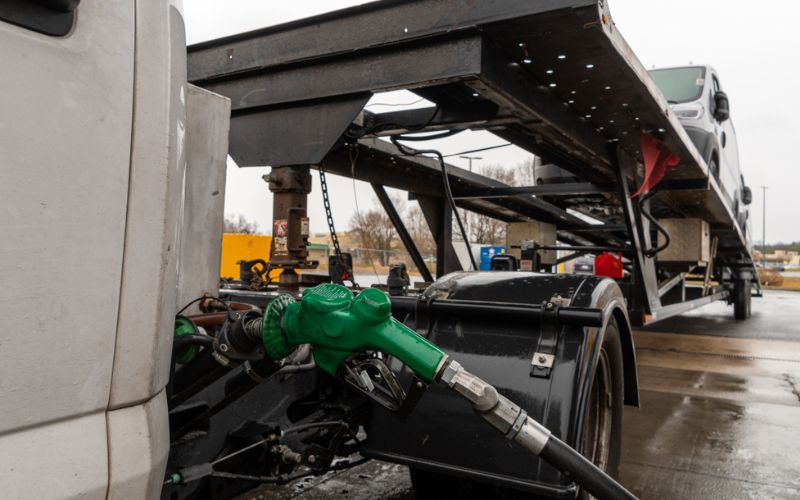
A big part of fleet management is the never-ending struggle to find new ways to reduce fleet costs, and to find ways that will reduce expenses in one area without creating inefficiencies or unanticipated additional costs to another area.
A great way to achieve cost savings is through optimization of your fleet. Optimizing routes, processes, and other areas lets you achieve the same or greater productivity with less. It focuses on getting more from your vehicles without impacting business performance.
Having systems in place to track vehicles to eliminate wasteful behaviors, unnecessary downtime and other issues that add to your overhead costs without providing any value are essential. Here are some strategies that all fleet managers can use to boost efficiency and lower expenses.

There are a few major areas of expenses involved in fleet management. Addressing these key areas create the biggest opportunities for significant cost savings.
Fuel costs are rising, so efforts to reduce these are essential.
Fleet maintenance costs and repairs are significantly increasing in today's economy, too, making this an important area to address now more than ever. While regular maintenance may still feel like a money drain, it is more cost effective than costly repairs. Tracking and monitoring vehicles accurately is essential to success.
While depreciation is unavoidable, it can be slowed through better maintenance or choosing vehicles that depreciate slower. As another huge fleet management expense, looking at ways to maximize lifespans and residual value of vehicles, and optimizing schedules to replace vehicles is important. With parts shortages for maintenance and repair along with truck/trailer inventory shortages continuing into late 2024, companies have to expand the lifecycle of vehicles more than they used to. Before they would be able to upgrade their fleet, now they need to keep a vehicle on the road longer which costs more.
Administration costs are a surprisingly large drain on most fleets. Scheduling routes or maintenance, tracking compliance and safety documentation, managing driver behavior, and other ongoing tasks take up a lot of time and payroll costs, not just of fleet management personnel but many employees.
Hidden return on investment costs are another factor. If you spend money on low-benefit or no-benefit items or activities, that is money that can't be spent on something that could boost productivity or efficiency, or otherwise drive the company forward, effectively resulting in an ongoing cycle of inefficiency costs.
Not all expenses are equal. Development and growth expenses, proactive maintenance costs to extend vehicle lifespan are beneficial and more proactive. On the other hand, some expenses are simply money wasted. Fleet optimization helps fleet managers eliminate or reduce costs that are wasteful.
Optimizing routes to reduce distances travelled, time driving, and minimize idling helps fleet managers in reducing fuel consumption costs.
Effective scheduling can make a big difference in the fuel efficiency of your operations and lower operating costs. GPS tracking and telematics technology can be a valuable tool to a fleet manager to do this. Optimizing routes means you can ensure fuel purchases are made at your authorized providers or gas stations to save money, too.
Using the same technology, you can then go a step further and optimize driving behavior to eliminate activities that increase fuel consumption, such as idling, aggressive accelerating, speeding, and more. A side benefit is that reducing these will also lower wear and tear on your vehicle fleet to lower fleet maintenance costs.
Tracking distances and fuel consumption helps you spot any vehicles that are gas guzzlers, to make informed decisions about moving to more fuel efficient vehicles or electric vehicles.
Optimize your maintenance efforts. Preventive and predictive maintenance costs help fleets run smoothly, reduce downtime, and extend the life of fleet vehicles. However, repair costs and delayed maintenance costs are more costly and don't offer productive value.
Start by optimizing your maintenance provider; find one that doesn't take excessive amounts of time on maintenance or repair work, and keeps to the promised deadlines, or your best scheduling efforts will be ruined. Vehicle tracking systems can help identify any issues in this area.
Some telematics solutions monitor vehicle health for you, to predict when maintenance is needed, for just-in-time maintenance and no unnecessary work, which helps with optimal scheduling. It further helps minimize downtime, as vehicle fault codes can be sent to your maintenance provider to expedite work.
Moving towards preventive maintenance, so you don't have any breakdowns and avoid excess wear and tear on other parts when one is malfunctioning, is critical. However, to really save money, taking a step beyond that to implementing a predictive maintenance system is a game changer for fleet managers.
Leveraging vehicle fault codes and telematics technology, vehicles can be flagged for maintenance only when necessary, and only for what needs doing, with time to schedule the work efficiently. This can also be taken one step further with telematics; engine fault codes can be identified and your maintenance team can view the codes to identify if a vehicle needs immediate repair or if they can send a mechanic out to work on the problem right away. Saving hundreds to thousands of dollars on breakdowns or tows or incorrect items in the service trucks that come out to deal with a repair.

Simplifying and streamlining administration, or even better, automating where possible, cuts down a lot of payroll hours. Automating route planning with telematics solutions that optimize with a click and can be rescheduled instantly with another click is a big time saver, for example, especially for larger fleets.
Vehicle tracking and integrated efficiency tools will save you time dealing with maintenance records, safety and compliance documentation, preparing management reports, forms for customer surveys/invoices or payments, and more.
With optimization and more proactive maintenance, you may find you have more vehicles than you need, taking up garage space and other resources. You can delay vehicle replacement or actively sell off excess vehicles. Vehicle downsizing can offer significant savings, and selling off surplus vehicles can free up resources for other initiatives. With vehicle tracking, you can identify if there are specific vehicles or vehicle types that are being underused, and sell those off. Telematics can help with predictive insights, to ensure you don't sell off too many.
Optimized fleet management boosts efficiency of your operations, making more money available to implement more efficiency or growth initiatives. Compounded savings are possible.
You can either start by implementing one of the previous strategies, and use the savings to help you start on the next strategy, or do an overhaul of your systems to lower overall costs in one go. Since so much of fleet management is so interconnected, and tools to help you with one strategy will work for another strategy, it is just as easy to overhaul everything. Savings can be significant enough to warrant the initial investment into this overhaul.
A telematics solution makes the process changeover much easier, and helps with ensuring optimizations are effective. Demos are available so businesses can try out telematics on a few vehicles and roll them out to more of the fleet as needed.

Fleet managers can implement fleet video telematics solutions to reduce administration time and gain necessary, real-time, accurate information and algorithm-based recommendations to make decisions and optimize. It ensures fleet managers have all the necessary tools to make cost-saving strategies work as intended, without roadblocks.
Connected Vehicles can help you set up efficient and simple-to-use telematics solutions to track many elements of your fleet operations, and provide clear reporting and insights, so you can identify and address multiple inefficiencies that waste valuable company resources.



